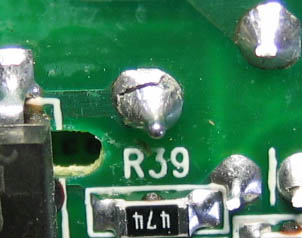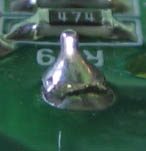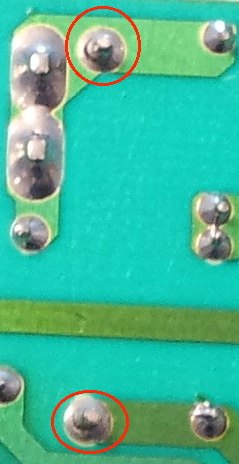It’s Da Joint!… Fractured Solder Joint, that is


Fractured, Fractured
Heat up… cool down… heat up… cool down… or was it movement during cooling? Several things can cause fractured solder joints:
- Thermal cycling, especially when the running (high) temperature is a significant fraction of the melting point of the solder
- Running temperature very high and too close to the melting point of the solder, even if there is no (significant or any) thermal cycling
- Component lead movement during solder cooling
- Mechanical shock sufficient to crack the joint, which will be easier if the joint is already weak
Whatever the cause, fractured solder joints are an all too common failure mode of any form of electronics using soldered connections, and especially a printed circuit board. The pictures above are classic examples, which hopefully will prove useful to those troubleshooters who have not yet seen fractured solder joints and need to know what to look for.
The example above is a classic: very visible break in the “solder mountain”. The dark area should not be there… in the top view picture, the middle (fractured) joint ought to look like the one above and to the right of it: nice and smooth “mountain peak” with no dark areas nor other discontinuities. To get a sense of scale, each of those “peaks” is roughly 3-4 mm in diameter.
This particular break was so extreme, it was easy to measure no continuity between the “peak” and the base of that one joint, which normally should always have continuity. Rarely are fractured joints so visible or so easy to test; more often the fracture is very difficult to see: a much thinner line. And all too often, the joint will have intermittent continuity and lack thereof. Here’s another example:

Even in this slightly blurry photo, the dark circles around the middle of each red-encircled “solder mountain” can be readily seen.
More Examples: Fractured Solder Joint Photo Gallery

And?… What To Do?
Clearly, resolder any and all fractured solder joints for reliability. If you are working on a device with intermittent problems and upon close inspection any joints appear that they may be fractured, you’ll save time by assuming that they are fractured and just going ahead and resoldering them.
If there are signs of excess heat, such as the joint being gray and grainy when the surrounding joints are shiny clear silvery, and/or discoloration of the circuit board or anything nearby, the joint fracture may reoccur. It would behoove one to investigate the cause of why that component’s lead is running too hot and fracturing:
- Poor design?
- Circuit failure causing more current flow through this component, thus more heat?
If there are no signs of excess heat, look for mechanical forces pushing upon the component whose lead is fracturing. Nothing?… it just may have been bad factory soldering.